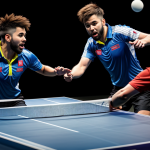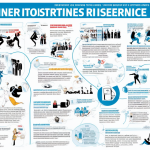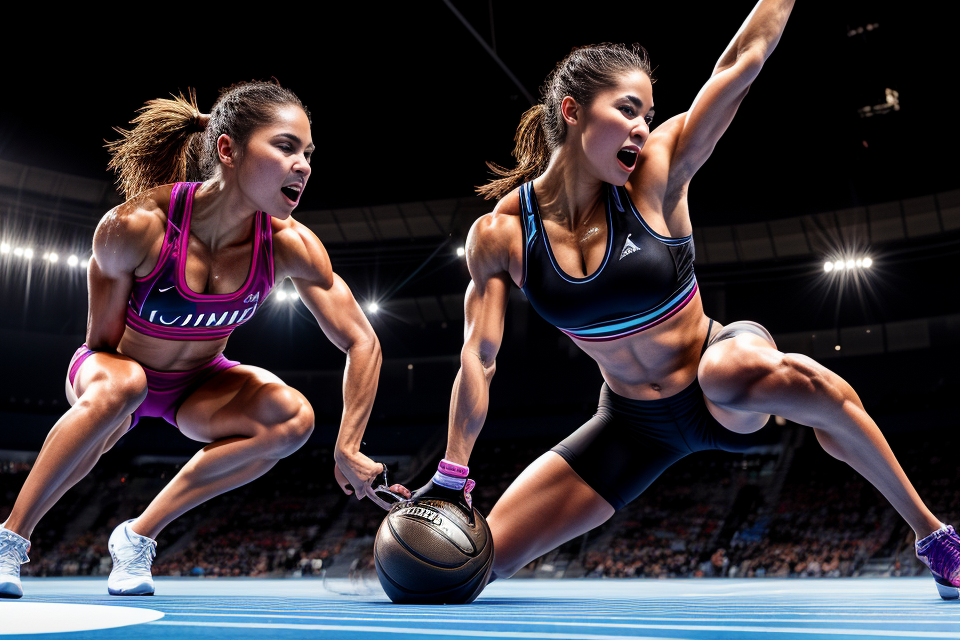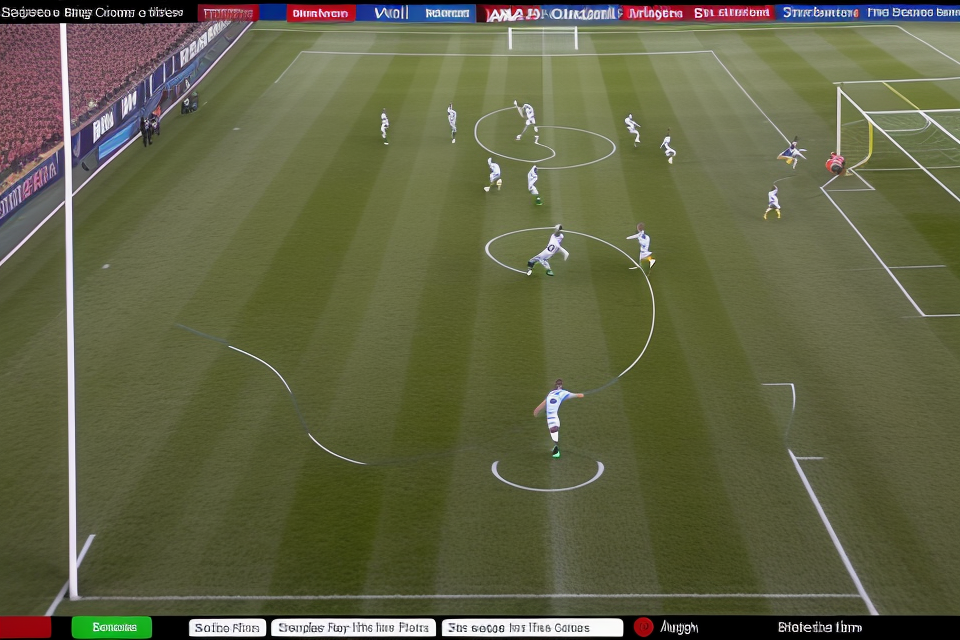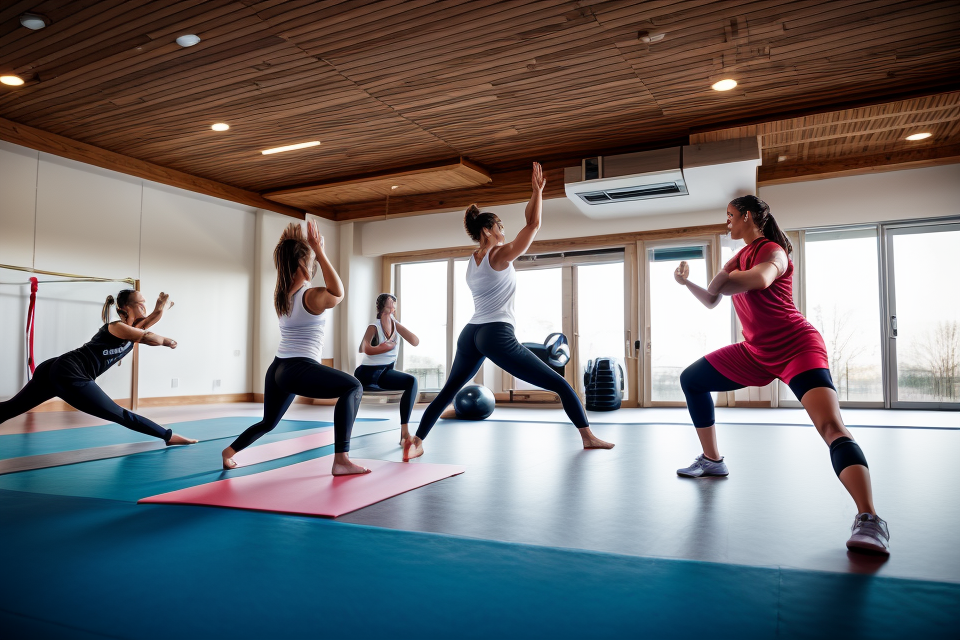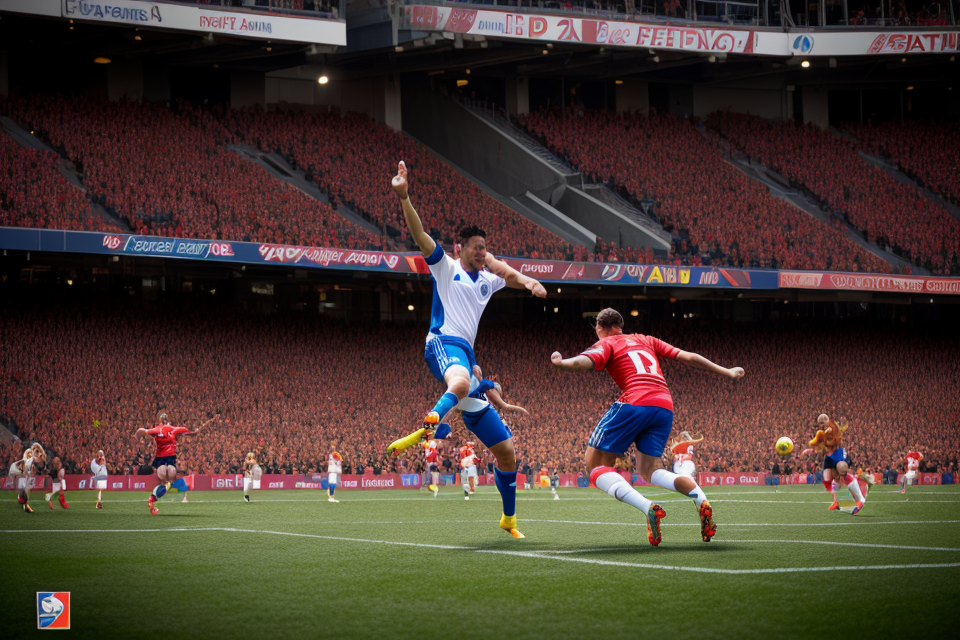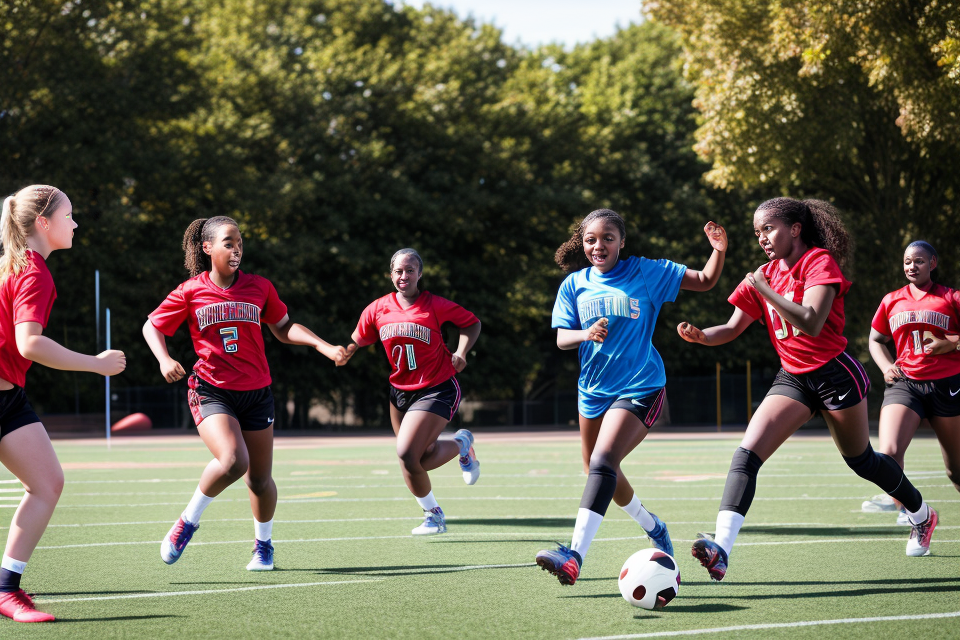Girls have come a long way in the world of sports. No longer are they relegated to the sidelines, but they are now taking center stage and making their mark in a variety of sports. But the question remains, what is the best sport for a girl to play? The answer is not as simple as it may seem, as different sports offer unique opportunities for growth, development, and success. In this article, we will explore the many options available to female athletes and provide insight into how to find the perfect sport to unleash their inner champion.
Understanding the Importance of Sports for Girls
Benefits of Sports for Girls
Sports participation among girls offers a myriad of benefits that extend far beyond the physical realm. By engaging in sports, girls can develop crucial life skills, enhance their self-esteem, and establish a strong sense of self. Here are some key benefits of sports for girls:
1. Physical Fitness
Participating in sports encourages girls to maintain a healthy and active lifestyle, which is essential for overall physical health. Through regular exercise, girls can improve their cardiovascular endurance, build strength, and develop coordination and flexibility.
2. Self-Confidence and Self-Esteem
Sports provide girls with opportunities to challenge themselves, learn new skills, and achieve personal goals. As they progress and see improvements in their abilities, girls can develop a sense of self-confidence and self-worth that carries over into other areas of their lives.
3. Social Skills and Teamwork
Sports often require cooperation and communication, which helps girls develop strong social skills and learn the importance of teamwork. By working together towards a common goal, girls can build trust, respect, and understanding among their teammates.
4. Leadership and Problem-Solving
Sports offer girls the chance to take on leadership roles, such as team captain or coach, and to develop problem-solving skills through strategic planning and decision-making. These experiences can help girls become effective leaders in their personal and professional lives.
5. Academic Achievement
Research has shown that girls who participate in sports tend to have better academic performance and higher graduation rates than those who do not. Sports can help girls develop time management skills, discipline, and a strong work ethic, all of which contribute to academic success.
6. Reduced Risk of Substance Abuse
Girls who participate in sports are less likely to engage in substance abuse, as sports can provide a positive outlet for stress relief and a sense of belonging. This can lead to a healthier and more productive lifestyle overall.
7. Positive Body Image
Sports can help girls develop a positive body image by promoting healthy habits and emphasizing the importance of physical fitness rather than a specific aesthetic ideal. This can lead to greater self-acceptance and self-respect.
In conclusion, participating in sports offers a wide range of benefits for girls, including improved physical health, enhanced self-esteem, and the development of essential life skills. Encouraging girls to explore and engage in various sports can help them unlock their full potential and lead fulfilling, active lives.
Overcoming Stereotypes and Barriers
In order to fully understand the importance of sports for girls, it is essential to examine the various stereotypes and barriers that often hinder their participation in athletic activities.
Gender Stereotypes
One of the most significant barriers facing female athletes is the prevalence of gender stereotypes, which can limit their opportunities and discourage their involvement in sports. Traditional gender roles often dictate that women should be passive, nurturing, and focused on appearance, rather than being active, competitive, and athletic. As a result, girls may be discouraged from pursuing sports due to societal expectations and pressures.
Lack of Access and Resources
Another major barrier to female participation in sports is the lack of access to resources and opportunities. In many communities, there may be a shortage of sports facilities, equipment, and trained coaches, particularly for female-oriented sports. Additionally, financial constraints can also play a role, as many families may not be able to afford the costs associated with participating in sports, such as registration fees, travel expenses, and necessary gear.
Cultural and Social Factors
Cultural and social factors can also influence the level of female participation in sports. In some communities, there may be a strong emphasis on traditional gender roles, which can limit opportunities for girls to engage in athletic activities. Additionally, social stigma and discrimination can discourage girls from pursuing sports, particularly in communities where sports are not widely accepted or supported.
Overcoming these Barriers
Despite these barriers, there are steps that can be taken to encourage and support female participation in sports. By addressing the root causes of these issues, it is possible to create a more inclusive and supportive environment for female athletes.
- Challenging Gender Stereotypes: Raising awareness about the negative impact of gender stereotypes on female athletes is crucial. By challenging these stereotypes and promoting a more balanced view of gender roles, girls can feel more empowered to pursue their athletic interests.
- Increasing Access to Resources: Providing greater access to sports facilities, equipment, and trained coaches can help ensure that all girls have the opportunity to participate in sports. Governments, schools, and community organizations can play a role in providing these resources and ensuring that they are accessible to all.
- Supporting Diversity and Inclusion: Fostering a culture of diversity and inclusion in sports can help create a more welcoming environment for female athletes. This can involve promoting sports that are traditionally associated with female participation, as well as providing support and resources for girls from diverse backgrounds.
By addressing these barriers and working to create a more inclusive environment for female athletes, it is possible to unleash the champion within and help girls reach their full potential.
Identifying the Best Sports for Girls
Physical and Mental Abilities
When identifying the best sports for girls, it is important to consider both their physical and mental abilities. This means evaluating the specific skills and strengths that each individual athlete possesses, as well as the mental fortitude and resilience that is necessary to excel in any sport.
One important factor to consider is the athlete’s natural physical abilities, such as their speed, agility, and strength. For example, sports like track and field, soccer, and basketball may be well-suited for athletes who possess natural speed and agility. On the other hand, sports like gymnastics and wrestling may be better suited for athletes who have natural strength and power.
Another important factor to consider is the athlete’s mental abilities, such as their focus, determination, and ability to handle pressure. For example, sports like tennis and golf may be well-suited for athletes who possess a high level of mental focus and concentration. Meanwhile, sports like swimming and diving may be better suited for athletes who have a natural ability to handle pressure and perform under pressure.
Ultimately, the best sport for a female athlete will depend on their unique combination of physical and mental abilities, as well as their personal interests and goals. By identifying their strengths and weaknesses, as well as their passions and interests, female athletes can work with their coaches and trainers to find the ideal sport that will allow them to unleash their full potential and become champions in their chosen field.
Popular Sports for Girls
Girls today have a wide range of sports to choose from, each with its own unique benefits and challenges. Here are some of the most popular sports for girls:
Soccer
Soccer is one of the most popular sports for girls, with millions of players worldwide. It is a high-intensity sport that requires excellent cardiovascular fitness, speed, agility, and coordination. Soccer is also a team sport, which can help girls develop important social skills such as teamwork, communication, and leadership.
Basketball
Basketball is another popular sport for girls, with a strong emphasis on teamwork, passing, and shooting. It requires good hand-eye coordination, speed, and agility, as well as the ability to strategize and make quick decisions on the court.
Volleyball
Volleyball is a sport that combines elements of basketball, tennis, and gymnastics. It requires excellent hand-eye coordination, jumping ability, and footwork, as well as the ability to work together as a team to spike, block, and set the ball.
Tennis
Tennis is a sport that requires excellent hand-eye coordination, strength, and endurance. It is an individual sport that can help girls develop their mental toughness, focus, and discipline.
Track and Field
Track and field is a sport that requires excellent cardiovascular fitness, speed, and endurance. It includes events such as sprinting, long-distance running, hurdles, and jumping, and can help girls develop their overall athleticism and physical fitness.
These are just a few examples of the many sports available to girls today. By exploring different sports and finding the one that best suits their interests and abilities, girls can unleash their inner champion and achieve their full potential as athletes.
Finding the Right Fit
Selecting the right sport for a female athlete is a crucial aspect of her journey towards becoming a champion. The process of finding the right fit involves a range of factors, including physical attributes, personal interests, and long-term goals. In this section, we will explore some of the key considerations that should be taken into account when identifying the ideal sport for a female athlete.
- Physical Attributes: A crucial factor in finding the right fit is to consider the physical attributes of the athlete. Different sports have varying demands on strength, endurance, agility, and other physical abilities. For instance, sports such as soccer, basketball, and volleyball require excellent cardiovascular endurance, while sports like gymnastics and dance demand strength and flexibility. It is essential to identify sports that align with the athlete’s physical abilities and potential for growth.
- Personal Interests: Another critical factor is to take into account the athlete’s personal interests. Sports that are enjoyable and fun to play can help keep the athlete motivated and engaged. It is essential to explore different sports and find the one that resonates with the athlete’s personality and interests.
- Long-term Goals: Setting long-term goals is an essential aspect of becoming a champion. It is crucial to identify sports that align with the athlete’s long-term goals, whether it is to compete at the collegiate or professional level or to simply enjoy the sport for leisure. The sport should provide opportunities for growth, development, and success.
By considering these factors, female athletes can find the right sport that suits their physical attributes, personal interests, and long-term goals. Identifying the ideal sport is the first step towards unleashing the champion within and achieving success in sports.
Developing Skills and Building Confidence
Training Techniques for Female Athletes
Individualized Training Programs
One of the key components of successful athletic training is the development of an individualized training program. This program should be tailored to meet the specific needs and goals of each female athlete. By taking into account factors such as an athlete’s age, body type, and level of experience, coaches can create a training regimen that is both effective and safe.
Cross-Training
Another important aspect of training for female athletes is cross-training. This involves incorporating a variety of exercises and activities into an athlete’s training program in order to prevent overuse injuries and promote overall fitness. For example, a female soccer player might also engage in strength training, yoga, and cardiovascular exercise in order to build a well-rounded fitness routine.
Mental Preparation
In addition to physical training, mental preparation is also crucial for female athletes. This includes developing strategies for managing stress and anxiety, visualizing success, and building confidence. By incorporating mental training into their overall athletic regimen, female athletes can develop the mental toughness and resilience necessary to succeed at the highest levels of competition.
Nutrition and Hydration
Finally, proper nutrition and hydration are essential components of successful athletic training. Female athletes need to consume a balanced diet that provides adequate amounts of protein, carbohydrates, and healthy fats. They also need to stay hydrated by drinking plenty of water before, during, and after training and competition. By prioritizing their nutritional and hydration needs, female athletes can optimize their performance and support their overall health and well-being.
The Power of Teamwork
In sports, teamwork is crucial to success. When female athletes participate in team sports, they not only learn how to work together towards a common goal, but they also develop valuable life skills such as communication, leadership, and trust.
Here are some of the benefits of teamwork in sports for female athletes:
- Building Confidence: Playing on a team allows female athletes to develop their skills and gain confidence in their abilities. When they work together with their teammates, they can accomplish things that they may not have been able to do alone.
- Developing Communication Skills: Effective communication is essential in any team sport. Female athletes learn how to communicate clearly and effectively with their teammates, which is a valuable skill in any setting.
- Learning Leadership: Being a leader on a team requires confidence, communication skills, and the ability to motivate others. Female athletes who participate in team sports have the opportunity to develop these skills and become effective leaders.
- Fostering Trust: Trust is a crucial component of any successful team. When female athletes work together with their teammates, they learn to trust one another and rely on each other to accomplish their goals.
Overall, participating in team sports can help female athletes develop valuable life skills and build confidence in themselves and their abilities. By working together towards a common goal, they can accomplish things that they may not have been able to do alone and learn to trust and rely on one another.
Overcoming Fear and Doubt
Overcoming fear and doubt is a crucial step in discovering the ideal sport for female athletes. Many young women may have concerns about their abilities, fear of failure, or anxiety about the expectations placed upon them. It is important to address these issues head-on and provide them with the tools they need to overcome these obstacles.
One effective way to help female athletes overcome their fears is to provide them with a supportive environment. This can include creating a positive team culture, providing mentorship and guidance from experienced coaches and athletes, and offering opportunities for them to develop their skills in a safe and encouraging environment.
Another important strategy is to help them develop a growth mindset. This involves helping them understand that their abilities and talents can be developed through hard work, dedication, and perseverance. By teaching them to embrace challenges and view failures as opportunities for growth, they can learn to overcome their fears and build confidence in their abilities.
It is also important to address any physical or psychological barriers that may be preventing them from fully engaging in their chosen sport. This can include providing access to proper equipment, facilities, and training programs, as well as offering resources for mental health support and injury prevention.
Ultimately, overcoming fear and doubt requires a combination of support, encouragement, and a growth mindset. By helping female athletes develop these skills, they can unlock their full potential and become champions both on and off the field.
Choosing the Perfect Sport for Your Daughter
Factors to Consider
When it comes to choosing the perfect sport for your daughter, there are several factors to consider. These factors will help you determine which sport best suits her skills, interests, and personality.
- Physical Abilities: Consider your daughter’s physical abilities, such as strength, endurance, flexibility, and coordination. Some sports may require more strength, while others may require more endurance or agility.
- Interests and Passions: Take into account your daughter’s interests and passions. If she loves animals, sports like equestrian or gymnastics may be a good fit. If she enjoys teamwork and strategy, sports like soccer or basketball may be more suitable.
- Personality Traits: Consider your daughter’s personality traits, such as competitiveness, leadership skills, and resilience. Some sports may require a more dominant personality, while others may thrive on teamwork and collaboration.
- Available Resources: Consider the resources available to your daughter, such as coaches, training facilities, and equipment. Some sports may require more specialized equipment or training, which may be more accessible in certain areas.
- Opportunities for Growth: Consider the opportunities for growth and development in each sport. Some sports may offer more opportunities for scholarships or professional careers, while others may offer more opportunities for personal growth and development.
By considering these factors, you can help your daughter find the perfect sport that will allow her to unleash her inner champion and reach her full potential as an athlete.
Finding a Supportive Community
As a parent, you want to ensure that your daughter is in an environment that nurtures her growth and development as an athlete. One of the essential factors to consider when choosing a sport for your daughter is finding a supportive community. A supportive community provides an environment where your daughter can thrive, receive guidance, and build lasting relationships with her peers.
Here are some aspects to consider when searching for a supportive community:
- Access to Mentorship: Look for a community that offers access to experienced coaches or mentors who can guide your daughter’s development as an athlete. A good mentor can provide invaluable advice, constructive feedback, and support, helping your daughter to overcome challenges and reach her full potential.
- Positive and Inclusive Culture: A supportive community is one that fosters a positive and inclusive culture. This environment should be free from negativity, bullying, and discrimination. A positive culture promotes teamwork, encourages healthy competition, and celebrates individual and team achievements.
- Networking Opportunities: Being part of a supportive community also means having access to networking opportunities. This can open doors to various resources, such as college scholarships, professional connections, and access to specialized training facilities. A strong network can provide your daughter with valuable resources and opportunities to advance her athletic career.
- Parental Involvement: Consider the level of parental involvement in the community. Parents who are actively engaged in supporting their children’s athletic pursuits can make a significant difference. They can provide transportation to practices and competitions, offer emotional support, and assist with fundraising efforts. Parental involvement can help create a more positive and supportive environment for your daughter.
- Opportunities for Growth and Development: A supportive community should provide ample opportunities for growth and development. This includes access to regular practices, competitions, and training camps. The community should also encourage personal development through leadership programs, community service initiatives, and academic support. These opportunities can help your daughter become a well-rounded athlete and individual.
By considering these aspects, you can find a supportive community that will help your daughter thrive as an athlete and reach her full potential. Remember, choosing the right sport and community is a crucial decision that can have a lasting impact on your daughter’s life. Take the time to research and evaluate different options to ensure that you find the perfect fit for her.
Balancing Academics and Athletics
One of the primary concerns for parents when it comes to their daughter’s participation in sports is the delicate balance between academics and athletics. While sports can provide numerous benefits for young women, such as improved physical fitness, increased self-esteem, and teamwork skills, it is essential to ensure that their academic responsibilities are not compromised.
Academic success is crucial for a child’s future, and parents must be mindful of the time and energy their daughter dedicates to sports. Therefore, it is vital to choose a sport that does not interfere with her academic commitments. Parents should consider the schedule of the sport, the time commitment required, and the potential for travel and conflicts with school events.
Additionally, parents should work closely with their daughter’s school to ensure that they are providing the necessary support for their daughter’s academic success. This includes communicating with teachers, coaches, and school administrators to ensure that the demands of sports do not hinder her academic progress.
Moreover, parents should encourage their daughter to develop good study habits and time management skills. This includes setting aside dedicated study time, staying organized, and seeking help when needed. By fostering these skills, parents can help their daughter balance academics and athletics effectively.
In conclusion, balancing academics and athletics is a crucial consideration when choosing a sport for a young woman. Parents should work closely with their daughter, the school, and coaches to ensure that the demands of sports do not compromise her academic success. By fostering good study habits and time management skills, parents can help their daughter achieve both athletic and academic excellence.
Pursuing Excellence: Tips for Female Athletes
Setting Goals and Staying Motivated
Setting goals is an essential aspect of an athlete’s journey towards success. It provides direction, focus, and a sense of purpose. For female athletes, setting goals is especially important as it helps in overcoming obstacles and breaking barriers. Here are some tips on how to set goals and stay motivated:
Define Your Goals
The first step in setting goals is to define them clearly. This involves identifying what you want to achieve and creating a roadmap to reach your objectives. It is crucial to set realistic and achievable goals, but also to aim high and challenge yourself. Setting specific, measurable, attainable, relevant, and time-bound (SMART) goals can help in achieving success.
Create a Vision Board
Visualizing your goals can help in staying motivated and focused. Creating a vision board can be an effective way to keep your goals in sight and serve as a constant reminder of what you are working towards. It can also help in tracking your progress and celebrating small victories along the way.
Break Down Your Goals
Breaking down your goals into smaller, manageable tasks can make them less overwhelming and more achievable. This involves creating a step-by-step plan and setting deadlines for each task. Breaking down your goals also allows you to track your progress and make adjustments as needed.
Surround Yourself with Positive Influences
Staying motivated requires a positive mindset and a support system. Surrounding yourself with positive influences, such as coaches, teammates, and mentors, can help in staying motivated and focused on your goals. They can provide encouragement, guidance, and inspiration when needed.
Celebrate Your Successes
Celebrating your successes, no matter how small, can help in boosting your motivation and confidence. It is essential to acknowledge and appreciate your achievements, as it reinforces your belief in yourself and your abilities. Celebrating successes also provides a sense of accomplishment and serves as a reminder of how far you have come.
By following these tips, female athletes can set realistic and achievable goals, stay motivated, and unleash their full potential.
Building a Strong Support System
Having a strong support system is crucial for female athletes who aspire to achieve excellence in their chosen sport. It plays a vital role in helping athletes navigate the challenges they face and providing them with the encouragement and resources they need to succeed.
A strong support system includes various individuals who provide different types of support, such as coaches, teammates, family members, and friends. These individuals can offer emotional, practical, and motivational support, which can significantly impact an athlete’s performance and overall well-being.
Coaches
Coaches are an essential component of a strong support system. They provide technical guidance, offer constructive feedback, and help athletes develop a training program tailored to their individual needs. A good coach can inspire and motivate athletes, instill confidence, and push them to reach their full potential.
In addition to coaching skills, a coach’s personality and communication style can significantly impact an athlete’s experience. It is crucial to find a coach who is empathetic, understanding, and able to communicate effectively with their athletes. A coach who can create a positive and supportive environment will help athletes thrive and reach their goals.
Team
Nutrition and Recovery for Optimal Performance
Maintaining proper nutrition and recovery practices are essential components for female athletes to achieve optimal performance. Here are some key considerations to keep in mind:
- Hydration: Staying adequately hydrated is crucial for athletes, as it helps regulate body temperature, maintains blood volume, and supports overall health. Female athletes should aim to drink at least 8-10 cups of water per day, and more during intense training or competition.
- Energy balance: A balanced diet that provides sufficient energy to support training and competition is critical. Female athletes should consume a mix of carbohydrates, proteins, and healthy fats, and aim to fuel their bodies with nutrient-dense foods such as whole grains, fruits, vegetables, lean meats, and nuts.
- Fluids and electrolytes: During prolonged exercise or in hot weather, female athletes should consume fluids and electrolytes to prevent dehydration and support optimal performance. Sports drinks containing electrolytes can be beneficial, but water is also an effective option.
- Protein: Consuming adequate amounts of protein is essential for muscle repair and growth. Female athletes should aim to consume 0.5-0.7 grams of protein per pound of body weight per day, through sources such as chicken, fish, beans, and nuts.
- Post-exercise nutrition: Consuming carbohydrates and protein within 30 minutes after exercise can help support muscle recovery and glycogen replenishment. Female athletes should aim to consume a snack or meal that includes both carbohydrates and protein after training or competition.
- Rest and recovery: Adequate rest and recovery is crucial for optimal performance and injury prevention. Female athletes should aim to get at least 7-9 hours of sleep per night, and incorporate rest days or low-intensity training days into their training schedule to allow for recovery.
By prioritizing proper nutrition and recovery, female athletes can support their physical and mental health, optimize their performance, and reduce the risk of injury.
Encouraging a Lifetime of Active Living
Achieving success in sports requires a commitment to a lifetime of active living. Female athletes can encourage this lifestyle by adopting healthy habits, staying motivated, and maintaining a positive attitude.
- Develop Healthy Habits
To encourage a lifetime of active living, female athletes should focus on developing healthy habits. This includes:
- Eating a balanced diet that provides the necessary nutrients for optimal performance
- Staying hydrated by drinking plenty of water before, during, and after exercise
- Getting enough sleep to allow the body to recover and repair itself
-
Incorporating strength training and flexibility exercises into their workout routine
-
Stay Motivated
Staying motivated is essential for female athletes who are pursuing excellence. To maintain motivation, they should:
- Set realistic goals that are achievable and measurable
- Celebrate successes and milestones along the way
- Seek support from coaches, teammates, and family members
-
Remind themselves of the reasons why they started pursuing their sport
-
Maintain a Positive Attitude
A positive attitude is crucial for female athletes who are striving for excellence. They can maintain a positive attitude by:
- Focusing on the process rather than the outcome
- Learning from failures and setbacks
- Embracing challenges as opportunities for growth
- Surrounding themselves with supportive and uplifting people
By adopting these tips, female athletes can encourage a lifetime of active living and achieve their full potential in their chosen sport.
Creating Opportunities for Future Generations
Creating opportunities for future generations is an essential aspect of empowering female athletes. It involves fostering an environment that supports and nurtures young female athletes, allowing them to reach their full potential. This section will explore some ways to create opportunities for future generations of female athletes.
- Providing Access to Resources:
- Access to coaches and mentors who can guide and support young female athletes in their journey towards success.
- Access to quality training facilities, equipment, and technology that can enhance their performance and reduce the risk of injury.
- Access to educational resources that can help them balance their athletic pursuits with their academic responsibilities.
- Promoting Gender Equality:
- Advocating for equal representation and opportunities for women in sports at all levels, from grassroots to elite.
- Encouraging the creation of female-focused sports organizations and initiatives that provide opportunities for female athletes to participate and compete.
- Addressing and challenging gender stereotypes and biases that may hinder the progress of female athletes.
- Building Role Models and Mentors:
- Encouraging successful female athletes to serve as role models and mentors for younger generations.
- Providing opportunities for female athletes to connect and learn from each other, such as through networking events, camps, and clinics.
- Celebrating the achievements and successes of female athletes to inspire and motivate future generations.
- Empowering Female Coaches and Leaders:
- Supporting the development and growth of female coaches and leaders in sports.
- Encouraging the hiring and promotion of female coaches and administrators in all levels of sports organizations.
- Providing opportunities for female coaches and leaders to learn from each other and share best practices.
By creating opportunities for future generations of female athletes, we can help ensure that they have the resources, support, and inspiration they need to succeed and achieve their full potential.
Embracing the Joy of Sport
Discovering the ideal sport for female athletes involves not only physical prowess but also finding joy in the pursuit of athletic achievement. Embracing the joy of sport is a crucial aspect of achieving success as a female athlete.
One way to embrace the joy of sport is to find activities that align with personal interests and passions. For example, if a female athlete has a passion for animals, sports such as equestrian or canine sports may be a great fit. By participating in sports that align with personal interests, female athletes can experience a sense of fulfillment and enjoyment that extends beyond the physical aspect of competition.
Another way to embrace the joy of sport is to surround oneself with a supportive community of fellow athletes. Being part of a team or joining a sports club can provide female athletes with a sense of belonging and camaraderie. Supportive teammates and coaches can offer encouragement, guidance, and motivation, which can help female athletes stay focused and engaged in their athletic pursuits.
Furthermore, embracing the joy of sport involves developing a growth mindset. Instead of viewing setbacks or failures as defeats, female athletes can adopt a mindset of learning and growth. By focusing on the process of improvement and embracing challenges as opportunities for growth, female athletes can cultivate a positive attitude towards athletic competition.
Finally, finding enjoyment in the sport can also involve setting realistic goals and celebrating small victories. By setting achievable goals and acknowledging progress, female athletes can maintain a positive outlook and stay motivated. Celebrating small victories along the way can help female athletes build confidence and stay committed to their athletic pursuits.
In conclusion, embracing the joy of sport is a crucial aspect of discovering the ideal sport for female athletes. By finding activities that align with personal interests, surrounding oneself with a supportive community, developing a growth mindset, and setting realistic goals, female athletes can experience a sense of fulfillment and enjoyment that extends beyond the physical aspect of competition.
Celebrating the Achievements of Female Athletes
Female athletes have made remarkable strides in recent years, breaking records and defying stereotypes. Celebrating their achievements is not only important for recognizing their hard work and dedication, but it also serves as an inspiration for future generations of female athletes. Here are some ways to celebrate the achievements of female athletes:
- Highlight their accomplishments: Whether it’s a gold medal win at the Olympics or a record-breaking performance at a local competition, female athletes deserve to have their accomplishments recognized and celebrated. This can be done through social media posts, articles, and other forms of media.
- Recognize their contributions to the sport: Female athletes have made significant contributions to their respective sports, from developing new techniques and strategies to advocating for equality and inclusion. Recognizing these contributions is important for acknowledging the impact that female athletes have had on the sport.
- Support their journey: Being a female athlete is not easy, and it requires a lot of hard work, dedication, and perseverance. Supporting female athletes on their journey, whether it’s through financial support, mentorship, or simply cheering them on, is important for helping them achieve their goals.
- Promote gender equality in sports: One of the most effective ways to celebrate the achievements of female athletes is to promote gender equality in sports. This includes advocating for equal pay, opportunities, and representation for female athletes, as well as challenging harmful stereotypes and biases that can limit their potential.
By celebrating the achievements of female athletes, we can inspire and empower the next generation of female athletes to pursue their dreams and achieve greatness.
The Continuing Journey to Equality in Sports
While there have been significant strides in promoting gender equality in sports, the journey towards true equality is far from over. Female athletes continue to face various challenges, including unequal pay, limited opportunities, and gender-based discrimination. In this section, we will explore some of the ongoing struggles faced by female athletes and the efforts being made to address these issues.
Unequal Pay and Sponsorship Opportunities
One of the most prominent issues facing female athletes is the gap in pay and sponsorship opportunities compared to their male counterparts. Despite achieving similar levels of success and attracting large audiences, female athletes often receive lower pay and fewer endorsement deals. This disparity has led to a call for greater transparency and equal pay policies, as well as increased efforts to secure sponsorships and endorsement deals for female athletes.
Limited Media Coverage and Exposure
Another challenge faced by female athletes is the limited media coverage and exposure they receive compared to male athletes. This lack of media attention not only impacts the athletes’ ability to attract sponsorships and endorsement deals but also limits the visibility and recognition of their achievements. To address this issue, advocates are pushing for increased media coverage of women’s sports and the promotion of female athletes as role models and champions.
Addressing Gender-Based Discrimination and Harassment
Female athletes also face the challenge of gender-based discrimination and harassment, both on and off the field. From sexual harassment and assault to discriminatory comments and behaviors, female athletes must navigate a hostile environment that can impact their mental and emotional well-being. To combat this issue, organizations and advocates are working to promote a culture of respect and inclusion, while also implementing policies and procedures to address instances of discrimination and harassment.
Advocating for Change and Promoting Equality
Despite these ongoing challenges, female athletes continue to advocate for change and promote equality in sports. From speaking out against discriminatory practices to lobbying for equal pay and sponsorship opportunities, female athletes are using their platforms to bring attention to these issues and push for greater recognition and support. As more female athletes continue to rise to prominence and break down barriers, the journey towards equality in sports is poised to continue.
Inspiring the Next Generation of Champions
Inspiring the next generation of female athletes is a crucial aspect of unleashing the champion within. It involves mentoring young athletes, sharing experiences, and imparting valuable knowledge to help them reach their full potential. Here are some tips for inspiring the next generation of champions:
- Be a role model: As a female athlete, you have the opportunity to serve as a role model for young athletes. By exhibiting strong work ethics, integrity, and a positive attitude, you can inspire the next generation to pursue their dreams and strive for excellence.
- Share your story: Share your experiences, both successes and failures, with young athletes. Your story can serve as a source of inspiration and motivation, helping them understand the importance of resilience, determination, and hard work.
- Offer guidance and support: Offer guidance and support to young athletes, helping them navigate the challenges of competitive sports. This can include providing advice on training, nutrition, and mental preparedness, as well as offering emotional support during difficult times.
- Encourage participation: Encourage young athletes to participate in sports and compete at various levels. By creating a positive and supportive environment, you can help foster a lifelong love of sports and promote the development of well-rounded individuals.
- Advocate for equality: Advocate for equality in sports, promoting fair treatment and opportunities for all athletes, regardless of gender. By championing equality, you can help create a more inclusive and supportive environment for female athletes to thrive.
By following these tips, you can inspire the next generation of female athletes and help them unleash their full potential.
FAQs
1. What are the benefits of girls playing sports?
There are numerous benefits of girls playing sports, including improved physical health, increased self-confidence, and the development of important life skills such as teamwork and leadership. Additionally, participating in sports can help girls build strong friendships and create lasting memories.
2. What sports are best for girls?
There is no one-size-fits-all answer to this question, as the best sport for a girl will depend on her individual interests, strengths, and goals. Some girls may excel in sports that require speed and agility, such as track and field or soccer, while others may prefer sports that emphasize teamwork and strategy, such as basketball or lacrosse. Ultimately, the best sport for a girl is one that she enjoys and feels passionate about.
3. Is it necessary for girls to play sports in school?
While it is not necessary for girls to play sports in school, participating in athletics can be a valuable and enriching experience. School sports teams provide a supportive and inclusive environment for girls to develop their skills, make friends, and compete at a high level. Additionally, many schools offer a wide range of sports programs, making it easy for girls to find a sport that they enjoy and can excel in.
4. How can I help my daughter find the right sport?
One of the best ways to help your daughter find the right sport is to encourage her to try a variety of different activities and sports. This will allow her to discover what she enjoys and what she is naturally good at. Additionally, talking to coaches and other parents can provide valuable insights and guidance on which sports may be the best fit for your daughter. Ultimately, the most important thing is to support your daughter’s interests and passions, and to help her find a sport that brings her joy and fulfillment.



